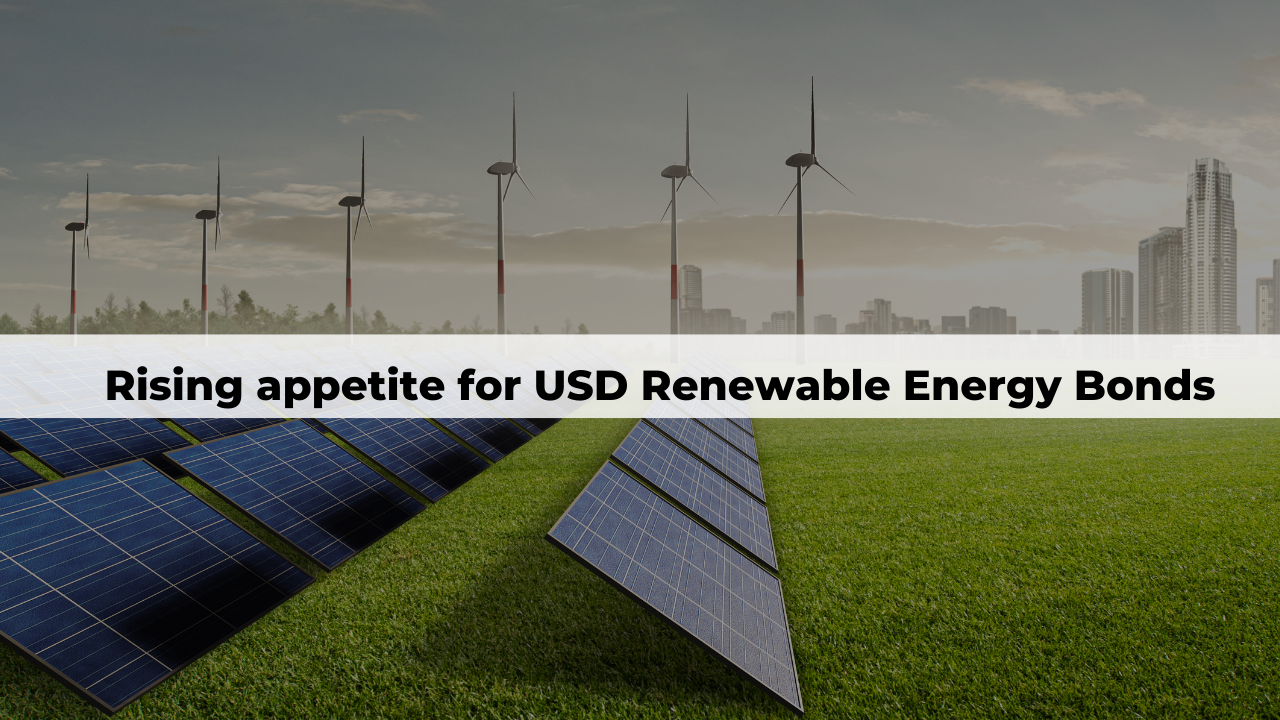
Rising appetite for USD Renewable Energy Bonds
India is the world's 3rd largest consumer of electricity and the world's 3rd largest renewable energy producer with 38% of energy capacity installed in the year 2020 (136 GW of 373 GW) coming from renewable sources.
Recently we have heard a lot of News regarding the investments of various companies in the renewable energy sector.
India's renewable energy (RE) capacity has increased 286% in the last 7.5 years to 151.4GW at end-2021. It is expected to grow further due to the government’s strong policy push to hit its 2030 green targets. Its climate targets (Nationally Determined Contributions (NDC)), as well as its plan to achieve carbon neutrality by 2070, include:
- 500GW non-fossil energy installed capacity
- Reduce carbon emission intensity by 45% (vs 2005) by 2030
- Increase the power capacity share of non-fossil fuel-based energy to 50% by 2030
-Expand RE capacity to 500GW by 2030 vs the installed capacity of 151GW at the end-2021.
Supporting policy measures include renewable purchase obligations (RPOs) for state distribution companies (DISCOMs), renewable energy certificates (RECs), and must-run status (MRS) to reduce curtailment and viability gap funding. The 2022-23 union budget included an additional Rs.195 billion allocation for a solar production linked incentive (PLI) scheme and the issuance of sovereign green bonds for public sector projects.
According to the Ministry of New and Renewable Energy, India requires Rs.1.5-2 trillion of annual investment in Renewable Energy capacity to meet the 2030 targets, offering growth opportunities for Renewable Energy-independent power producers.
Reason for Rising Indian Renewable Energy USD Bonds:
Over the past 5-6 years, USD bonds have been the preferred financing instruments for Indian Renewable Energy independent power producers despite duration and currency mismatches. This is due to lower overall financing costs, the proliferation of green and ESG-labelled bonds, and a much wider investor base. What started as a refinancing tool for independent power producers to lower their financing costs at the project level and recirculate capital into new product development, USD bonds are now being used to finance greenfield projects at the holding company level.
With a total of $14.5 billion of gross issuance and $12 billion of outstanding bonds, India RE USD bonds now account for 36% of the country’s HY corporate USD bond universe. And by the nature of their business, Renewable Energy independent power producers are a perfect fit for green bonds. As a result, 85% of their outstanding USD bonds have a green bond structure and they represent 35.6% of Asia’s high-yield corporate green USD bond space. Investors have welcomed the Renewable Energy USD bonds, especially fund managers. On average, the bonds issued between 2021 to 2022 YTD were 4.4 times oversubscribed. Asian investors took 50% of the allocations, and US and European investors 25% each.
Role of Adani Green Energy:
Part of the Adani Group, Adani Green Energy is the flagship company in terms of Renewable Energy development that leads the group’s green push. Adani Green has well-established corporate management, project development, execution mechanisms, and financing strategies that serve as solid fundamentals for capacity growth and capturing Renewable Energy market opportunities.
As of March 2022, Adani Green had 5.4GW of operating capacity and 14.9GW of locked-in capacity under execution. It also had 200,000 acres of sites for potential development; 100% of its portfolio is contracted with 25-year fixed tariff PPAs, with an average tariff of Rs.2.99/KWh. The operating projects should provide steady cash flows to service Adani Green’s debt and fund new project development. At the same time, the high reliance on debt-funded capacity expansion may expose Adani Green to capital market volatility and refinancing risks. This should be partly mitigated by Adani Green’s access to domestic and international capital markets as well as strategic partnerships with international firms.
Bond Structures:
RE independent power producers aim to lower financing costs and package their bonds using project securities. Adani Green’s three USD bonds, each structured differently, represent the three most common bond structures in India’s RE sector.
ADGREG ’24 and ARENRJ ’39 are ring-fenced by obligor groups RG1 and RG2, respectively. RG1 has a total of 930MW installed solar capacity from 25 projects across 10 states. RG2 has a total of 570MW installed solar capacity from 10 projects across two states. All the projects are up and running with 25-year power purchase agreements (PPAs) at fixed tariffs – i.e. they have visible cash flows. ADGREG ’24 is a bullet bond that is likely to be refinanced next year, and ARENRJ ’39 incorporates a sinkable repayment schedule with the tenor in line with the operating company’s concession period, i.e. lowering the refinancing risk.
ADANIG ’24 was issued at the holding company level. With no project security and being subordinated to Operating Companies, ADANIG ’24 is rated 1-2 points lower than the other two USD bonds. All three bonds have relatively tight covenants to offer extra comfort to bondholders. The currency mismatches are hedged via derivatives. Meanwhile, being green bonds, they will have standard reporting procedures on proceed allocation, project performance, and environmental impacts.
Disclaimer: Investment/Trading is subject to market risk, past performance doesn’t guarantee future performance. The risk of trading/investment loss in securities markets can be substantial. Also, the above report is compiled from data available on public platforms.
 Tanushree Jaiswal
Tanushree Jaiswal



